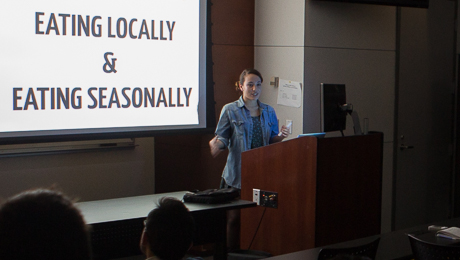The average consumer may not know that the lithium battery in a discarded cell phone can contaminate up to 60,000 liters of water, equivalent to three Olympic-size swimming pools.
Or that the sugar packets used at popular coffee chains and in restaurants make a cross-country journey from farm to production, or “food miles,” that contribute to the more than 6 million metric tons of carbon dioxide in greenhouse gasses emitted each year due to food production.
George Washington University students in the Economics of Sustainability, a green-leaf course offered by the Economics Department, that is part of the sustainability minor, recently came face to face with these statistics through research on key environmental issues such as food miles, electronic waste (e-waste) and waste water.
They found that unsustainable consumption is not only taking a toll on the environment, it is also costing money.
“The increasing urgency of the environmental crisis and the rising interest in the concept of sustainability is pushing economics to think rigorously about sustainable development,” said Ram Fishman, an assistant professor in the Columbian College of Arts and Sciences, who teaches the course.
Dr. Fishman launched the semester-long discussion to contextualize the economic effects of sustainable and unsustainable behaviors on an individual, national and global scale. Students in the course began presenting research on their personal environmental footprint last week.
“Since Awareness is the first step to behavior change, it is pretty sobering to find out how difficult it is to quantify one’s impact,” Dr. Fishman said. “Many of the student projects show just how complicated it is to demonstrate how each person’s environmental impact is connected to the bigger picture," he said.
For senior Saagar Enjeti, the project was not only an exercise in sustainable practices but also a life lesson.
When he moved off-campus and into a townhouse a few months ago, he estimated that he and his five roommates would pay an average of $30 dollars each for the monthly water utility bill. In June, they were surprised to find that they had used 41,140 gallons of water and owed a whopping $470 for the bill, thanks to a running toilet, outdated plumbing and multiple showers per day.
With a few adjustments, such as limiting showers and washing machine use and fixing the plumbing, they were able to reduce their water usage by nearly 90 percent and their water bill by more than 80 percent.
“People often think of climate change in the abstract because the effects are large and difficult to relate to the average citizen,” Mr. Enjeti said. “When you begin to price the damages of climate change, you demonstrate the effect on every citizen’s wallet, which is something we all care about.”
Frank Sesno, director of the School of Media and Public Affairs and creator of Planet Forward, a project focused on areas of energy, climate and sustainability in the Center for Innovative Media at GW, offered feedback during the presentations.
“The stuff about toilets, taps and showers is exactly the direction that sustainability needs to move into in this country,” he said.
Students Beatriz Domingues and Danielle Firestone touched on the 21st-century obsession with upgrading cell phone devices, citing the average upgrade happens every 18 months, despite the fact that most devices have a useful life of seven years.
This throwaway culture is compounded by the fact that only 1 percent of cell phones of the 1.2 billion sold each year are recycled. The rest are added to the 20 to 50 tons of e-waste worldwide, they said.
For Ms. Domingues and Ms. Firestone, the research hits close to home, since they both have had at least one cell phone per year for the last 10 years. Considering that one device emits 32 square meters of carbon dioxide and other greenhouse gasses, they have a combined carbon footprint of about 736 square meters.
“Green leaf courses primarily focus on content related to sustainability, but they also serve to emphasize engaging teaching methods and cross-disciplinary collaborations, as in Dr. Fishman's course,” said Lisa Benton Short, academic program director for sustainability and interim director of the university's sustainability initiative. The initiative is one of several that the university has developed to adress and effect change in a pressing national and international issue.
Economics in Sustainability is one of nearly 250 green-leaf courses offered at the university. The classes are designed to prepare students for the growing academic, research and career opportunities geared toward climate change, energy, conservation and other topics related to the environment.
The university also offers faculty the opportunity to revise their courses or create new courses that meet the green leaf designation and incorporate content related to sustainability through the Green Leaf Course Development Grants. Within the past two years, 10 courses have been funded through the grant program.
“The Sustainability Initiative is actively trying to grow the number of green leaf courses across the university to provide more options for students in the sustainability minor,” Dr. Benton-Short said.
“Through the grant program, we encourage faculty from all schools to partner with their colleagues from other departments to team-teach, or incorporate innovative assignments, new assessment techniques and service-learning components when developing new courses or revising their existing courses,” she added.
There are many excellent classes on sustainability being offered at GW, Dr. Fishman said. “This is something that is only just beginning to happen in the academic world, so being at GW is a great opportunity to get in on the action.”


